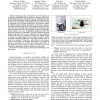618 search results - page 9 / 124 » Computational Models of Natural Language Argument |
COSIT
2007
Springer
13 years 11 months ago
2007
Springer
Consistent and flawless communication between humans and machines is the precondition for a computer to process instructions correctly. While machines use well-defined languages an...
ESOP
2005
Springer
14 years 27 days ago
2005
Springer
Program slicing is a well-known methodology that aims at identifying the program statements that (potentially) affect the values computed at some point of interest. Within imperat...
HRI
2010
ACM
14 years 2 months ago
2010
ACM
—Speaking using unconstrained natural language is an intuitive and flexible way for humans to interact with robots. Understanding this kind of linguistic input is challenging be...
IJCNN
2007
IEEE
14 years 1 months ago
2007
IEEE
— Serious efforts to develop computerized systems for natural language understanding and machine translation have taken place for more than half a century. Some successful system...
ACL
2007
13 years 8 months ago
2007
This paper presents a comparative study of five parameter estimation algorithms on four NLP tasks. Three of the five algorithms are well-known in the computational linguistics com...

